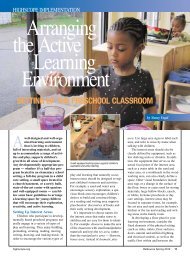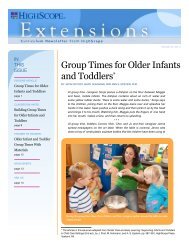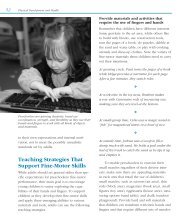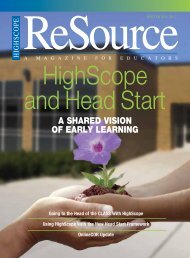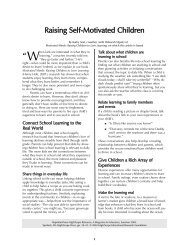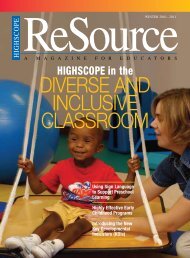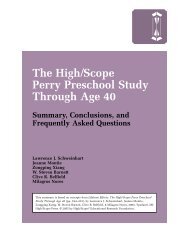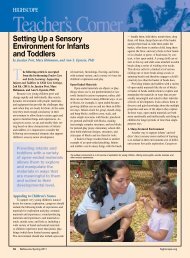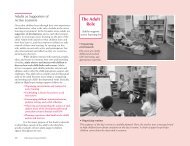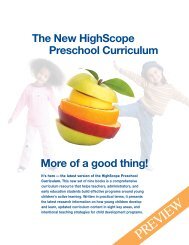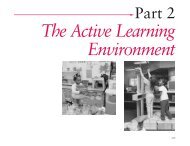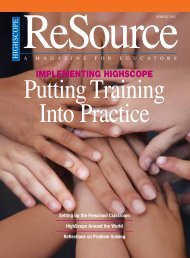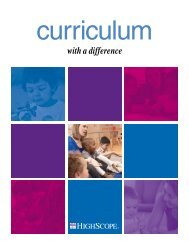Resource - High/scope In The Elementary Classroom
Resource - High/scope In The Elementary Classroom
Resource - High/scope In The Elementary Classroom
You also want an ePaper? Increase the reach of your titles
YUMPU automatically turns print PDFs into web optimized ePapers that Google loves.
HigH/SCoPE ELEMENTARY<br />
When adopting the problem-solving<br />
approach to conflict, teachers in an elementary<br />
program need to consider that<br />
school-aged children can be physically<br />
strong and able to cause considerable<br />
Teachers in traditional<br />
classrooms often<br />
indirectly encourage<br />
conflict by reinforcing<br />
the importance of<br />
privilege, status,<br />
and ownership.<br />
harm to others, unlike pre-K children<br />
who are still relatively small. Moreover,<br />
unlike many children in a pre-K program,<br />
school-aged children may be able<br />
to identify the problem without the<br />
Children at the Rose School use words and<br />
pictures to detail their plans for work time<br />
and then reflect on what they’ve done.<br />
teacher needing to define it for them.<br />
School-aged children may have had<br />
years of experience in conflict and thus<br />
may exhibit a greater sense of inflexibility<br />
to their solution; this may result<br />
in a longer period of time in finding a<br />
mutually satisfying solution.<br />
on the other hand, although schoolaged<br />
children may have experience with<br />
conflict, they may be inexperienced in<br />
having a say in the resolution. Schoolaged<br />
children seem to have an innate<br />
sense of fairness and conception of<br />
reason; therefore, their solutions are<br />
more likely to be logical than solutions<br />
proposed by preschool children. Lastly,<br />
school-aged children are more likely to<br />
remember previous conflicts and prior<br />
ways of solving problems. Teachers in<br />
an elementary program can facilitate the<br />
problem-solving process by empowering<br />
students to believe they are problem-<br />
solvers; giving children opportunities<br />
to solve non-threatening problems and<br />
to solve problems as a group; accepting<br />
children’s solutions; supporting children<br />
in their efforts to come up with a solution;<br />
and being consistent in allowing<br />
children to solve problems.<br />
Plan-Do-Review<br />
<strong>High</strong>/Scope’s plan-do-review in the<br />
elementary classroom is based on the<br />
same principles as plan-do-review in<br />
a preschool setting: it involves active<br />
learning, is a child-initiated time of the<br />
day, and uses the same adult-support<br />
strategies. in the plan-do-review process,<br />
children learn to take initiative, solve<br />
problems independently, work with<br />
others, and build knowledge and skills<br />
(Epstein, 2007).<br />
When elementary teachers first hear<br />
of plan-do-review, they worry that it<br />
takes time away from the curriculum.<br />
www.high<strong>scope</strong>.org ReSource Fall/Winter 2008 15



